February 10th, 2010
I traveled to India on January 31st to deliver a keynote address at a conference organized by the India Institute of Technology (IIT) in Mumbai. IIT is to India is MIT is to the United States: an elite educational institution specializing in science and technology. My hosts were Ravi Poovaiah and Ajanta Sen, a husband-and-wife team. This page is a collection of impressions of my trip, not a conventional trip report.
I know enough about India to know that it is far too complicated a society for me to ever fully appreciate, and my experiences certainly confirmed that belief. The experience was overwhelming; I still can’t seem to digest it properly. As yet, all I have from it is a whirlwind of memories; this essay will necessarily be disorganized. Let me begin with a random jumble of experiences and observations:
Silverware in the cafeteria that’s so flimsy that I bent the spoon. Sitting in the car, stopped in a jam, with extremely poor people tapping at the window, making motions towards their mouth indicating that they are hungry, and, following Ajanta’s lead, ignoring them. Spending vast amounts of time sitting in a car, traveling from Point A to Point B, at average speeds of perhaps 20 mph. Crazy, crazy traffic, with people cutting and weaving, leaving clearances measured in inches. People on motorcycles and motorscooters without helmets. I saw a family of four on a small motorcycle: daddy driving, one child in front of daddy, the other wedged between daddy and mommy. Eating lunches at the swankiest hotels in Mumbai. At the men’s room, an attendant turns on the water faucet for me and offers a squirt of liquid soap; he then hands me small hand towels to dry my hands. It’s almost humiliatingly decadent. The attendant at the entry to the hotel, opening the doors of cars and dressed in the most spectacular attire. Security at the swanky hotels checking every incoming car, checking the engine compartment, trunk, and even underneath the car. Armed guards everywhere. The Taj Mahal Hotel was the major target of the attacks last year, when 200 people died. It cost stupendous amounts of money to repair the damages. Ajanta took us to Leopold’s, a popular place that was attacked by the terrorists; three waiters died there. She recited details of the attacks and pointed out different places where the attackers had done different things.
I saw no carpet in Mumbai except in the heavily air-conditioned swanky hotels; the problems of humidity are too great. Indeed, I saw very little permanent construction in wood, because the humidity ruins that, too. Everything is done in stone, concrete, or plastic. There are a large number of shops selling slabs of granite, marble, and slate. The outsides of many buildings are stucco, which takes dark stains. There’s no sky in Mumbai; the sea haze is so thick that even sunsets are invisible. Instead, the sun disappears into the haze an hour or two before sunset.
The streets teem with small vendors selling much the same merchandize. We drove past hundreds (I do not exaggerate!) of tiny shops selling clothing, hats, leather bags, sandals (flip-flops are ubiquitous), and foods of all kinds. People will stop on the expressways and get out of their cars to attend to whatever business appeals to them, and the other drivers just whizz by.
I have seen more variations on the physiognomy of the human head than I thought possible. People with narrow, tall heads, people with strongly sloping foreheads, beaklike noses, sunken faces, extraordinarily wide or narrow mouths -- is this due to genetic variation or malnutrition or environmental poisons? I couldn’t get a decent milkshake in India; their recipe for milkshakes is milk, cream, sugar, and chopped ice. The milkshakes don’t appear to have any ice cream in them, or perhaps they aren’t mixed up; I don’t know but they’re terrible. When I got back to the states I went on a search for milkshakes and didn’t find anything until I reached SFO. There I had a really good vanilla milkshake.
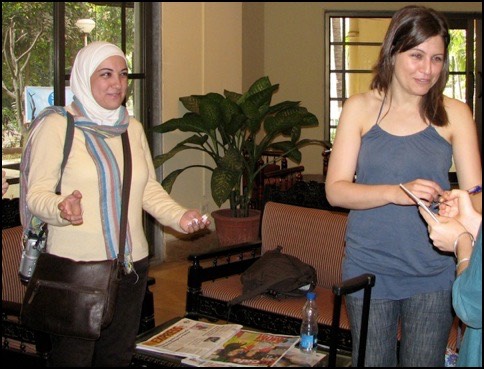
A discussion on peace in the Middle East with a Palestinian lady and an Israeli lady -- very sad because both were reasonable people, and both quite polite, even amicable, during the discussion, yet adamant that their minimum acceptable positions were incompatible.
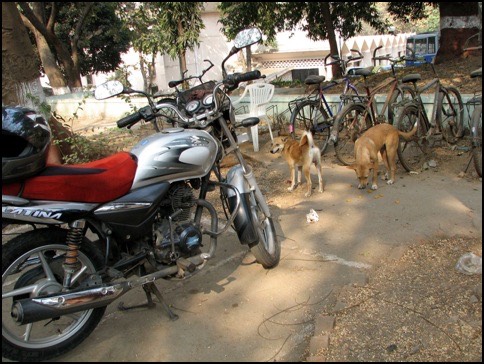
Dogs! There is quite a complex ecosystem of dogs here. They are not pets, but rather wild animals who are tolerated by the people. I’ve been studying them; they seem to have limited territorial range and act like tolerated scavengers. I saw no interaction between people and dogs; they avoided the eye contact I attempted to make with them. They’re all short-haired dogs (obviously), about 50 pounds. Smaller would get killed, larger probably needs too much food. However, they seem well fed -- what keeps their population in control? I see no cats anywhere -- obviously. I met two very friendly puppies but they seem to have an owner. He called them and they seemed slightly responsive, but I was uncertain as to their relationship with him.
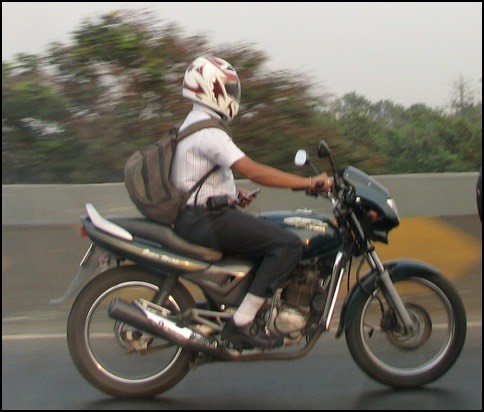
A motorcyclist who was doing something on his cellphone while driving. At least he was wearing a helmet, which only about half the bikers bother with.

The haze is mostly water vapor, not smog (although there is certainly smog). Those buildings are about a mile distant.
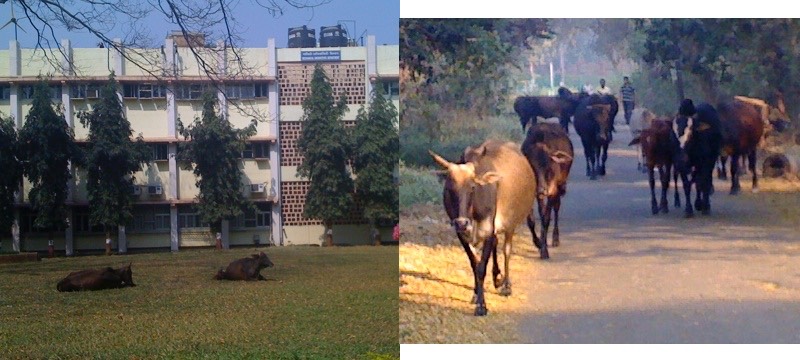
Cows in front of one of the academic buildings; more cows on a side road on campus.
My greatest difficulties arose from my difficulty in hearing. It’s not that I need a hearing aid or can’t hear faint sounds. My problem is that I can’t discriminate fine details of sound in a noisy environment. While I have a good ear for nuances of pronunciation, I simply cannot carry on a conversation in a noisy environment with anybody whose accent requires extra attention. It was worst in the restaurants, where the noise was deafening and I simply could not understand anything. I spent a lot of time smiling, nodding idiotically, and saying things like "Is that so?" and "I’ve often wondered about that." and "That’s interesting", hoping desperately that I didn’t say anything wildly inappropriate. My cleverest response was to deliberately garble my response so that it seemed intelligible but really didn’t say anything. That seemed to work. Perhaps they just figured that I was eccentric.
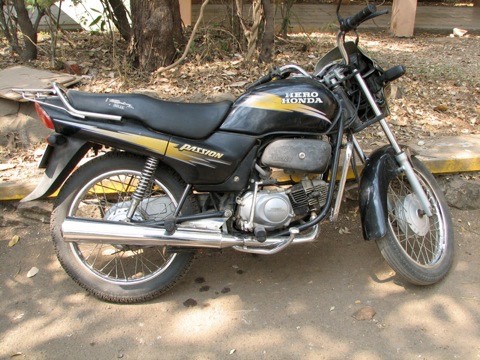
The venerable Honda 90, a classic motorcycle from the 1960s, lives on in India with a beefed-up 100cc engine. This thing sells for about $900 new!
I gave my keynote lecture on Thursday afternoon. It went well; I had prepared thoroughly and made no serious mistakes. I employed many of my standard stunts: throwing a ball hard at the wall, having it bounce back across the stage. Jumping around, stand-up crawling, running -- the usual nonsense. The audience seemed very pleased by my antics; at dinner afterwards Ravi and Ajanta asked if I would be willing to give another lecture on any topic I desired. I agreed to do so and they went to work re-arranging the next day’s schedule to squeeze me in. The next morning I presented Ajanta with a list of four possibilities and she chose one; it was a condensed version of my lecture on interactivity. I somehow got through the entire thing in the alloted time. Again, the audience seemed quite appreciative.
On Sunday I was interviewed by a local television personality. The interview itself went well but I was angry with myself for failing to honor Ajanta’s request to work in some mentions of IIT and the Design Center. I understood and sympathized with her request -- getting good PR is crucial to success in many of the projects she undertakes. So I really wanted to help. But the interviewer was more interested in my early games history. This is difficult work, because your mind has to work at top speed, carefully analyzing the question as it’s being asked, considering a range of possible answers, worrying about lines of answer that could lead into traps (most journalists like to have at least one gotcha question; this guy didn’t, but I couldn’t know that in advance). There’s also the need to phrase the answers smoothly, punchily, and deliver them with style and grace. All in all, a very intense experience, and I was unable during it to plot a path to address Ajanta’s needs. After all she’s done for me, I felt that I had let her down. Of course, I don’t remember anything that I said during the interview -- there’s no time for that.
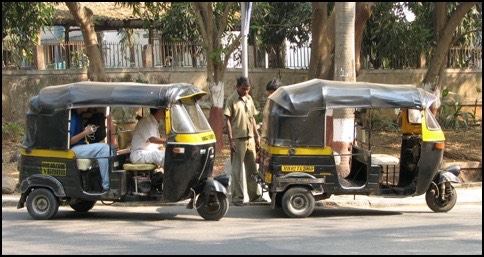
A common means of getting around: the three-wheel taxi. Holds two passengers. Two-stroke engine, no pollution controls, probably about 100 cc. Maximum speed maybe 40 mph.
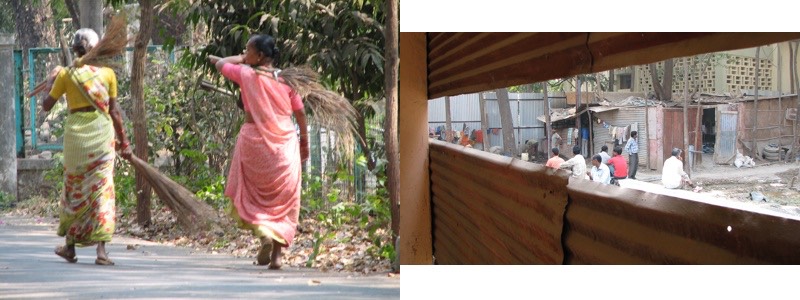
Laborers on campus
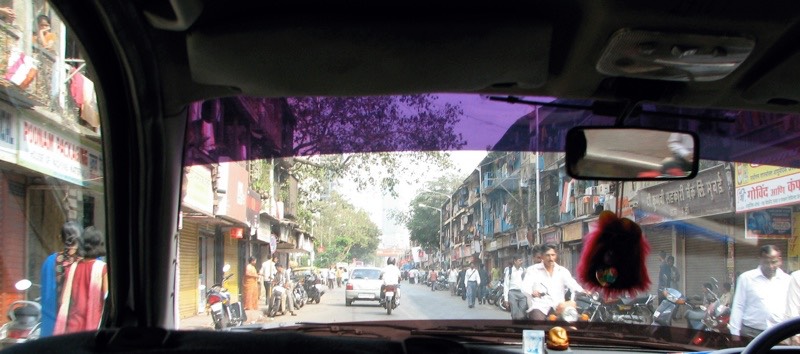
A street scene. People everywhere. Crowded traffic. I found sitting in the front seat too stressful as I kept flinching. At least I didn’t cry out, cover my eyes, or start reciting the Lord’s Prayer. Nothing untoward ever happened, but all the safety margins I take for granted were absent. One mistake by just about anybody and there would have been blood on the street.
A Remarkable Woman
My hostess was Dr. Ajanta Sen, a professor at the Design Center at IIT. She and her husband Dr. Ravi Poovaiah organized and ran the conference, so they were both very busy. Nevertheless, Ajanta spent a great deal of time catering to my needs, and we spent a lot of time talking. Ajanta greatly impressed me: she is an academic, an intellectual, an organizer, and a skilled politician. At one group lunch, she barely had time to eat because she spent so much time visiting with each table of attendees. She wears Western clothing when necessary but was careful to wear saris during the conference – emphasizing the importance of Indian culture. We had many intensely intellectual discussions, and what most impressed me was the combination of her mastery of Western rationalism achieved without compromising the Indian intellectual tradition. I surely do not understand Indian thinking, and so I had to struggle to understand some of the concepts she developed, but I have no doubt that there is valuable substance in that way of thinking. She plied me with books on India, and I am eager to delve into them (although there were so many that it will take me some time to plow through them). Together we came up with an ambitious scheme for science education that we’ll be developing over the next year or two. It’s so bold that I will not be surprised if it collapses before completion, but I think it has a good shot at success, and if we really pull this thing off, it will be a Big Thing. Whatever the outcome, I have no doubt that someday Ajanta will be running IIT or some big government ministry. She’s that kind of all-around impressive person.
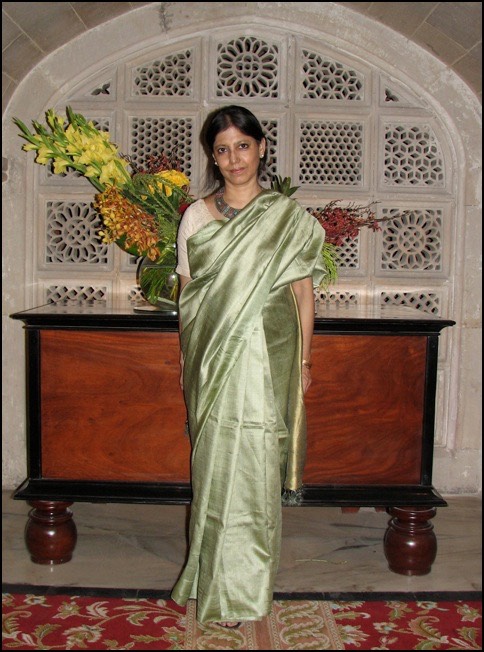
Dr. Ajanta Sen
